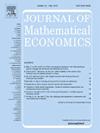On three welfare properties of monopoly in bilateral exchange
IF 0.7
4区 经济学
Q3 ECONOMICS
引用次数: 0
Abstract
We establish three welfare properties of the model of monopoly introduced by Busetto et al. (2023), where one commodity is held only by the monopolist, represented as an atom, and the other is held only by small traders, represented by an atomless part. First, we prove that a monopoly allocation is Pareto optimal if and only if it is an allocation which corresponds to an efficiency equilibrium. Second, we reformulate a paradox, due to Shitovitz (1997), to show that for any monopoly allocation there is another core allocation, distinct from both a monopoly allocation or a Walras allocation, which is, utility-wise, advantageous for the monopolist and nonadvantageous for the small traders. Finally, we prove a theorem which shows that monopoly is advantageous for the monopolist and nonadvantageous for each trader in the atomless part with respect to all Walras allocations which are not monopoly allocations.
论双边交易中垄断的三个福利属性
我们建立了Busetto等人(2023)引入的垄断模型的三个福利属性,其中一种商品仅由垄断者持有,表示为原子,另一种商品仅由小商贩持有,表示为无原子部分。首先,我们证明了垄断分配是帕累托最优的当且仅当它是一个对应于效率均衡的分配。其次,由于Shitovitz(1997),我们重新制定了一个悖论,以表明对于任何垄断分配,都存在另一个核心分配,不同于垄断分配或瓦尔拉斯分配,从效用角度来看,这对垄断者有利,对小商贩不利。最后,我们证明了对于所有非垄断分配的瓦尔拉斯分配,垄断对垄断者有利而对无原子部分的每个交易者不利的定理。
本文章由计算机程序翻译,如有差异,请以英文原文为准。
求助全文
约1分钟内获得全文
求助全文
来源期刊

Journal of Mathematical Economics
管理科学-数学跨学科应用
CiteScore
1.70
自引率
7.70%
发文量
73
审稿时长
12.5 weeks
期刊介绍:
The primary objective of the Journal is to provide a forum for work in economic theory which expresses economic ideas using formal mathematical reasoning. For work to add to this primary objective, it is not sufficient that the mathematical reasoning be new and correct. The work must have real economic content. The economic ideas must be interesting and important. These ideas may pertain to any field of economics or any school of economic thought.
 求助内容:
求助内容: 应助结果提醒方式:
应助结果提醒方式:


